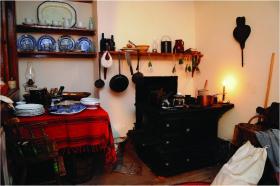Irish Tenement life in New York city
Published in 18th-19th Century Social Perspectives, 18th–19th - Century History, Issue 4 (Jul/Aug 2008), News, Volume 16
A simple table, two chairs and an old stove take up most of the cramped kitchen. (Keiko Neiwa)
Joseph and Bridget Moore may not be household names but they were real people, Irish immigrants who lived in 1869 at 97 Orchard Street, in New York’s Lower East Side. Now they and their family have been immortalised in the latest addition to the city’s Tenement Museum, located today at the same address.
The recreated 1869 bedroom, kitchen and parlour of the Moores joins five other apartments replicating the Jewish, German, Polish, Lithuanian and Italian experience and is the earliest depiction of immigrant living conditions. Every year some 130,000 people visit the 1864 building housing the museum (founded in 1988) to view the living quarters of the immigrant families who once resided there.
Censuses, church baptismal and death records, voter registrations, genealogical databases and local directories were consulted in order to piece together the Moores’ one-year stay in the building, augmented by educated guesses for the smaller details and the furnishings of their apartment. None of the original furnishings have survived. In fact, when museum researchers contacted a few descendants of one of the Moores’ daughters, Jane, they were told that the family did not even know that their ancestors had ever lived at 97 Orchard Street.
Joseph Peter Moore was 20 when he arrived in New York from Dublin. There he met Bridget Meehan, who, in common with many Irish female immigrants, came to the city alone at the age of 17. They married and in 1869 moved into 97 Orchard Street with the first three of their eight daughters (only four of the girls made it to adulthood). Joseph worked as a waiter and bartender while his wife minded the children at home. She later died aged only 36, while Joseph lived to be 71.
The apartment is frozen at a particular time—April 1869. Hospital records and a death certificate show that on 21 April the couple’s five-month-old daughter Agnes died of malnutrition, most likely from drinking the milk of diseased cows. The child’s coffin lies in the middle of the apartment, surrounded by chairs. The tiny (325 square feet) home’s mirrors have been covered in keeping with the practice of Irish wakes, and traditional Irish music and keening can be heard. Nineteenth-century Irish and American songs, researched and recorded by ethnomusicologist and musician Mick Moloney (formerly of the Johnstons), play, while images of broadsides and political cartoons are presented. One song decries employers who would not hire the Irish. One sympathises with Irish transplants in New York ‘all jumbled up together’ in a ‘paradise for rats’. And one warns, ‘Mothers, be careful and cautious’, and avoid ‘milkmen who are selling us swill’.
Visitors are invited to consider how our understanding of disease has changed from the mid-nineteenth century to the present, and how these changes have shaped the lives of 97 Orchard Street’s residents and countless other immigrants. The Moores are juxtaposed with the Katz family, Russian immigrants who lived there in the early 1930s. While the Moores (the earliest family life replicated) faced unsanitary conditions, swill milk, cholera, and little governmental oversight into housing conditions or health care, the Katz children learned about dental hygiene at school and were encouraged to drink milk as part of a healthy diet.
A simple table, two chairs and an old stove take up most of the cramped kitchen. The parlour is decorated with Catholic paraphernalia. Top hats, belonging to men who came to pay their respects, rest on tables and chairs. Perhaps, speculate the curators, Mr Moore offered the visitors some whiskey, and maybe Mrs Moore keened as the guests numbly picked at a buffet of bread, ham and boiled potatoes. They may have sat on mismatched chairs, facing the little whitewashed coffin with rosary beads lying on top. On the mantel over the coal-burning stove in the kitchen there could well have been bunches of dried herbal remedies like pokeweed and bottles of alcoholic patent medicines that had failed to keep Agnes alive.
The last word should go to Marion Casey, Assistant Professor of Irish Studies at New York University, and one of several historical advisers:
‘The Irish experience in America, especially for the nineteenth century, is distinguished by its urban nature. Not all of the Irish lived in a tenement, but the relationship that develops between a predominantly rural immigrant people and the metropolis in places like New York, Boston and Philadelphia is essential to understanding Irish and American history.’
















